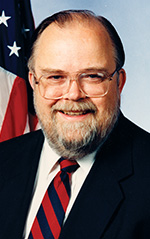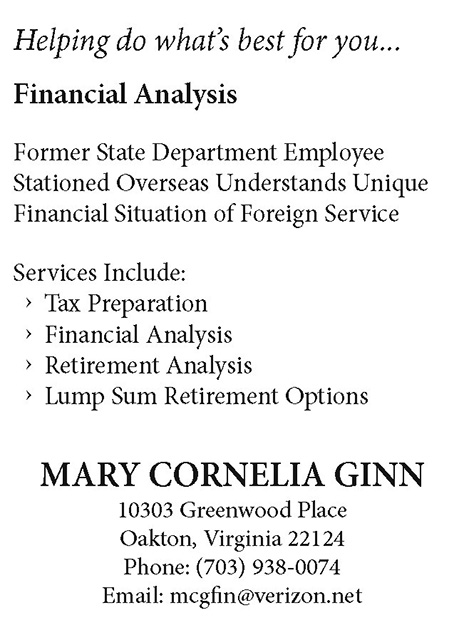Diplomats Make a Difference: The U.S. and Mongolia, 1986-1990
In the 1992 FSJ, Ambassador Joe Lake describes setting up the U.S. embassy in Ulaanbaatar. Today he and his son explore how that relationship was built.
BY JOSEPH E. LAKE AND MICHAEL ALLEN LAKE
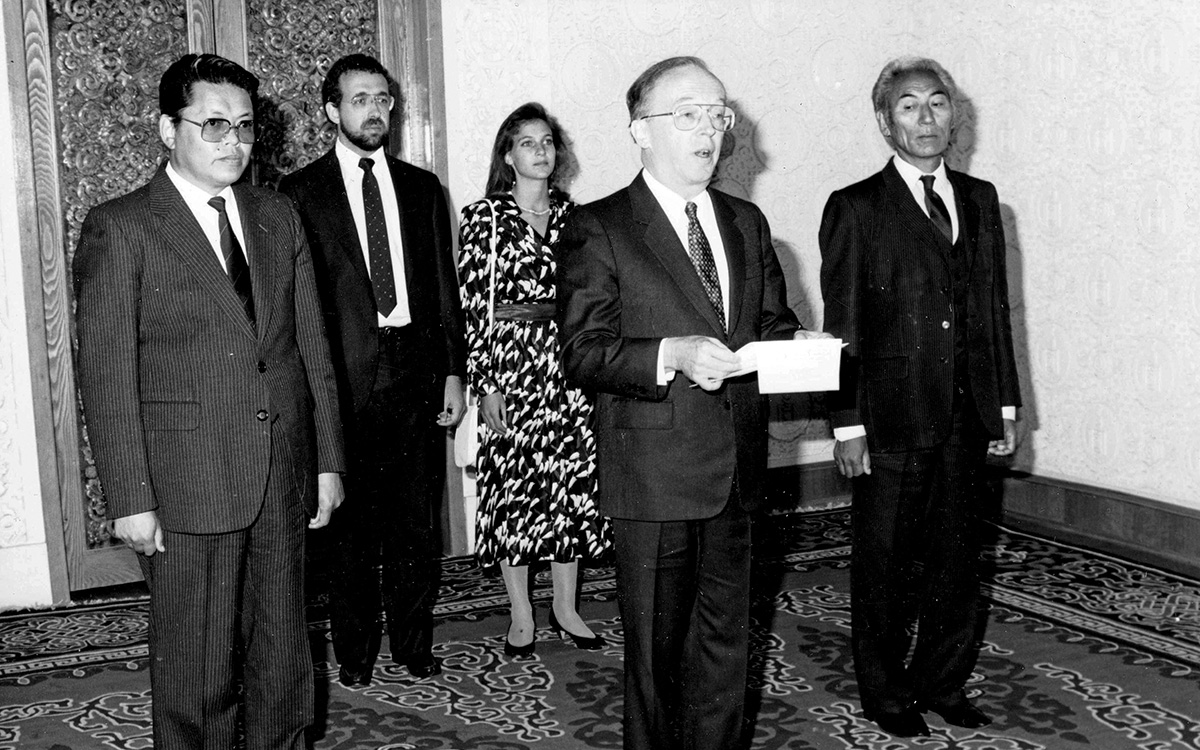
The first (nonresident) Ambassador to Mongolia Dick Williams presents his credentials in 1988. Flanking him is Davaagiv, later the second Mongolian ambassador to the U.S., to the left, and Mongolian Chief of Protocol Natsagdorj, right. At back, from left, is Steve Mann and Victoria Nuland, members of the first embassy team. Note: At that time, Mongolians used only one name.
Courtesy of Joe Lake
This is the story of how the United States—with no significant political or strategic interest in Mongolia, but with the strong personal support of Secretary of State James Baker and commitment by American diplomats—was able to build the foundation for a relationship that helped support Mongolia’s transition from the world’s second-oldest communist country and first Soviet satellite to an enduring democratic society and free market economy.
In September 1984 Donald C. Johnson, a political officer in U.S. Embassy Beijing, was received officially by the Mongolian Foreign Ministry, the first U.S. official since Vice President Henry A. Wallace in 1944 to be officially received by the Mongolian government. Yet it was another five years before the first permanently assigned American diplomats finally arrived in Ulaanbaatar. As Kenneth Jarrett, the Mongolian desk officer in 1987, wrote to the authors: “The level of interest was moderate … but there also was not much objection.” The U.S. waited for a signal from Mongolia; and Ulaanbaatar, from inside the Moscow orbit, waited for an approach from Washington.
It would take the end of the communist regime in March 1990 and Secretary Baker’s personal interest and initiative to change the dynamic. In a decision that surprised everyone at the Department of State, including the assistant secretary for East Asia, Baker decided to visit Mongolia in the summer of 1990. He visited in August and again in 1991, while Washington and the world were focused on the collapse of the Warsaw Pact and the disintegration of the Soviet Union.
Now 30 years later, in 2021, Mongolia has held its seventh democratic presidential election and peaceful transfer of power, testimony to the commitment of its people and the value of the U.S.-Mongolia tie. In a previous FSJ article, “Frontier Embassy” (December 1992), Joe Lake discussed the challenges of setting up the U.S. embassy in Ulaanbaatar in 1990. Here we focus on some of the important players and early events in building that relationship.
A Look Back
Modern Mongolia was created in 1921 with the support of White Russians, but they were soon ousted by the Mongolian People’s Party (renamed the Mongolian People’s Revolutionary Party in 1924) with support from the Red Army. In 1924 the Mongolian People’s Republic was proclaimed, and its dual roles as the second communist country in the world and the first of the Soviet satellite states were firmly established.
It is important to recall that despite ruling most of Eurasia in the 13th and 14th centuries, for hundreds of years afterward and until 1921 Mongolia did not exist as a modern nation-state but rather as an outer march of the Chinese empire, but not closely tied to the center. This lack of a democratic tradition, coupled with its 20th-century Marxist-Leninist experience, makes the country’s post-1990 success an even greater tribute to the Mongolian people and the new society they created.
In the early years of the Cold War, American interest in Mongolia was driven mainly by a desire to improve intelligence collection on the Soviet Union.
Because of its close ties with Mongolia as the second communist country and its strategic importance to them, the Soviet Union dominated Mongolia. Domestic political decisions in Ulaanbaatar were always made with an eye toward Moscow’s interests. In the 1930s Stalin’s purges were mirrored in Mongolia with the execution of potential opponents and attacks on nonsocialist traditional culture. After 1960 the Soviet Union underwrote the bulk of the country’s economic development.
The United States expressed episodic interest in normalizing relations with the Central Asian state, only to be foiled by resistance from U.S. allies in Taipei and foes in Moscow. In the early years of the Cold War, American interest in Mongolia was driven mainly by a desire to improve intelligence collection on the Soviet Union. In the 1960s two Foreign Service officers, J. Stapleton Roy and Curtis Kamman, were assigned to the University of Washington in Seattle to learn Mongolian in anticipation of opening a U.S. embassy.
That effort did not succeed, at least partially due to objections from Chiang Kai-Shek in Taipei, whom the U.S. still recognized as the legitimate leader of China. In 1972 the U.S. undertook another effort, sending FSOs William Brown and Allyn Nathanson to study Mongolian at the University of Leeds in the United Kingdom. This initiative failed largely due to the Soviets, who objected and, according to the former first deputy foreign minister of Mongolia, D. Yondon, waylaid a message from Ulaanbaatar to the Mongolian negotiators.
A Foundation of Debt and Foreign Assistance
From the outside, looking at official statistics and figures, the Mongolian economy in the 1980s appeared strong, a model of the benefits of the Soviet-style command economy. Yet there were systematic challenges that the government in Ulaanbaatar remained unable to address. As with many communist economies, Mongolia operated under a five-year plan. However, unlike most of its fellows in the communist world, 60 percent or more of the investment in those five-year plans was financed through foreign loans (primarily from the USSR and the German Democratic Republic).
Thus Mongolia accrued massive amounts of foreign debt to sustain the image of a successful workers’ paradise. In 1990 the Department of State estimated that Soviet aid to Mongolia had totaled $800 million to $1 billion annually, an excessive amount when you consider that the entire population of Mongolia numbered only 2 million at the time. By 1987 even the Mongolian leadership had begun to express private reservations that this level of debt was unsustainable. Even at that unsustainable level it was not possible to meet the demands of a growing and increasingly urbanized population; the country experienced ongoing shortages of foodstuffs, consumer goods and housing.
Though Mongolia had been firmly entrenched in Moscow’s orbit since the 1920s, those close ties were now threatening its stability. As internal challenges with infrastructure were coming to a head, the situation was also affected by Mikhail Gorbachev’s shake-up of the Soviet Union. Mongolia was now experiencing the ripples of glasnost and perestroika.
Given Moscow’s history of opposing Mongolian contact with the United States, it was a shock to the Mongolian leadership when, during a January 1986 visit to Ulaanbaatar, Soviet Foreign Minister Eduard Shevardnadze raised the question of Mongolia establishing relations with the United States. He said the Politburo of the Communist Party of the Soviet Union had reached the conclusion that opening such a dialogue would be in “our common interests.” The Reagan administration was unsure how to proceed; some senior officials were pleased with the change, and others opposed it.
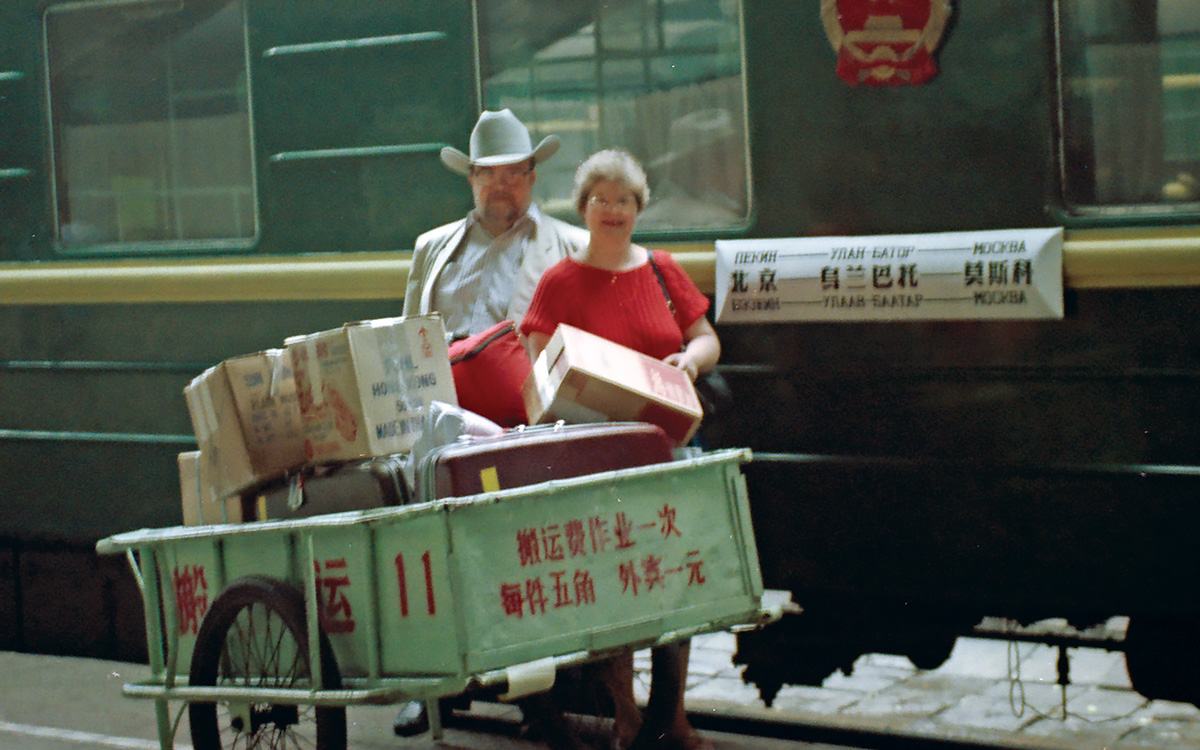
Joseph E. Lake and his wife, Jo Ann Kessler Lake, leave Beijing on the Mongolian branch of the Trans-Siberian railway for Ulaanbaatar in July 1990.
Courtesy of Joe Lake
Enter the United States
U.S. interest in Mongolia, meanwhile, was limited at best. Washington’s understanding of Mongolia was summed up in a declassified October 1984 CIA analysis: “Mongolia’s isolation and the limited Western presence there make it difficult to interpret Mongolian politics.” In the mid-1980s, senior officials in the U.S. government began to reach out to Mongolia through the embassy in Tokyo. There is confusion about what happened, and this is the focus of ongoing research by the authors. Mongolian observers speak of an American approach made through the U.S. Interests Section in Havana in January 1986, which the Mongolian Foreign Ministry learned about shortly after Shevardnadze’s visit. However, the head of the Havana section at the time, Curtis Kamman (one of the two FSOs dispatched to study Mongolian in the 1960s), remembers the conversation differently.
Regardless of these perceived and actual overtures, Gorbachev’s Vladivostok speech in July 1986, in which he said that Moscow was willing to withdraw its troops from Mongolia, was a signal that the USSR’s willingness to fully support the Mongolian state was waning. Coupled with Shevardnadze’s January comment, leaders in Ulaanbaatar saw that change was coming.
Apparently as a result of back-channel efforts by both sides, the U.S. was sufficiently encouraged to seek negotiations through Ambassador Vernon Walters, the U.S. Permanent Representative to the United Nations. Walters made the approach in August, but reticence continued among some on the Mongolian side. In the fall of 1986, the new deputy assistant Secretary of State responsible for China and Mongolia, J. Stapleton Roy, the other FSO who had studied Mongolian in the 1960s, arrived in Washington.
As Roy recounts in his unpublished oral history interview for the Association for Diplomatic Studies and Training, he “found … desultory interest” in Washington for establishing diplomatic relations with Mongolia. Not content with this state of affairs, he “gave the issue top priority” and began working to change the negotiating approach. His initiative coincided with the crumbling of resistance among the old guard in Ulaanbaatar. Negotiations were initiated on Dec. 12, 1986, and culminated in a joint signing ceremony on Jan. 27, 1987, in the Department of State—U.N. Ambassador Nyamdoo signing for Ulaanbaatar and Secretary of State George Shultz signing for Washington.

The original U.S. embassy in Ulaanbaatar shared a wall with the Palestine Liberation Organization embassy.
Courtesy of Joe Lake
U.S. Diplomats in Mongolia
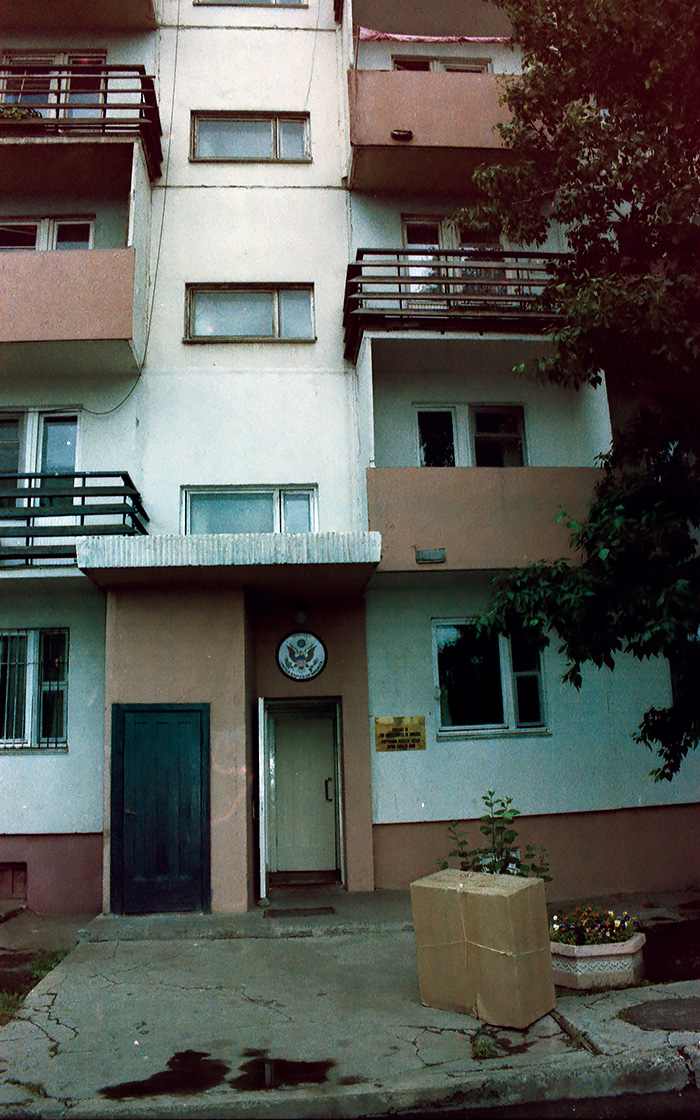
Courtesy of Joe Lake
When the signing ceremony took place, Joe Lake had just gone to work in the Executive Secretariat of the Office of the Secretary. He attended the ceremony out of curiosity, never realizing the impact Mongolia would have on his future. Three years later he would be the first U.S. ambassador resident in Mongolia.
Even though the U.S. now had a formal relationship with Mongolia, few in Washington were interested in building it. Mongolia had spent 66 years in the Soviet orbit and had almost no understanding of how to work with Washington. This was compounded by the fact that there was no strong driving purpose on the American side; Mongolia did not factor into commercial or business considerations, and the U.S. no longer had a national security intelligence collection interest there. Roy, however, pushed the bureaucracy through the China Mongolia desk to open the small embassy on a shoestring budget.
In March 1988 FSOs Steve Mann and Victoria Nuland arrived in Ulaanbaatar, and shortly thereafter, U.S. Embassy Ulaanbaatar formally opened its doors. Dick Williams arrived to present his credentials in September, but all three Americans soon departed the country because the department did not believe the new embassy was ready for the harsh Mongolian winter.
In his September 1988 report on presentation of his credentials, Williams stated that key factors would “severely constrain” the Mongolia-U.S. relationship “even if the political atmosphere continues to improve.” Embassy Ulaanbaatar was now staffed entirely by local employees. Whether the political atmosphere continued to “improve” or not depends on your perspective, but it certainly changed, wildly and unexpectedly.
In June 1989 two new FSOs, Michael Senko and Ted Nist, arrived and reopened the embassy. In December 1989 the embassy reported on a confluence of events including unexpected pro-democracy, anti–Communist Party mass demonstrations by young Mongolians that would produce a new generation of political leaders. The Mongolian government grappled with both the desires of the demonstrators and a changing geopolitical landscape in their relationship with the Soviet Union. The old regime announced its resignation on March 9, 1990, and Mongolia began its struggle to create a new political and economic future.
A Whole New World
The end of communist rule gave impetus to the relationship with the United States. The beginning of 1989 saw the installation of the administration of President George H.W. Bush, and with it, James A. Baker III became U.S. Secretary of State. Baker’s interest in Mongolia, which long predated his appointment as Secretary, became crucial for Ulaanbaatar in garnering both U.S. and international support in the challenging years ahead.
On April 19, 1990, U.S. Assistant Secretary for East Asian and Pacific Affairs Richard H. Solomon hosted a private lunch for Mongolian Ambassador Nyamdoo to introduce Joseph E. Lake, the not-yet-announced nominee to be the U.S.’s first resident ambassador to Mongolia. Nyamdoo asked Solomon about a possible visit to Mongolia by Secretary of State Baker, based on a previous invitation from the Mongolian government.
On May 1, 1990, Mongolia’s First Deputy Prime Minister Byambasuren arrived in Washington, where he met with both Secretary Baker and Vice President Dan Quayle. This was the third meeting between senior U.S. and Mongolian officials in a six-month period—a frequency that would have been unheard of for most countries with such a limited relationship with the United States and simply unimaginable over the previous six decades. The visit was the first public indication that Baker was the driving force on the U.S. side. The extent of the Secretary’s interest still had not registered with most elements of the U.S. government, including within the State Department.
A few weeks after the meeting, Baker announced that he would visit Mongolia in the late summer. The immediate result was the acceleration of negotiations for a Peace Corps agreement and the confirmation process for the first resident ambassador. In a telling indication of the department’s lackadaisical attitude toward Mongolia, a May 7, 1990, cable announced the nomination of Joseph E. Lake as “Ambassador to Micronesia.” Questioned by Embassy Ulaanbaatar, Protocol sent a second, corrected cable. Lake was confirmed on June 22 and arrived in Ulaanbaatar on July 13. On July 20, it was announced that Secretary Baker would be visiting Mongolia on Aug. 2. This was the beginning of the challenge to energize a disinterested Washington bureaucracy. The Mongolians were beginning to get the attention they needed to build a sustained relationship with the United States.
Though Mongolia had been firmly entrenched in Moscow’s orbit since the 1920s, those close ties were now threatening its stability.
Unfortunately, Baker’s visit to Mongolia was cut short. As the Secretary’s plane was preparing to land, his party received word that Saddam Hussein had invaded Kuwait. The plane circled while Baker’s staff got up to speed on what was happening in the Middle East, leading to a confused reaction on the ground. When it finally landed, both the Mongolian government and the embassy staff received word that the trip would not go exactly as planned.
Secretary Baker would only be able to spend one day in Mongolia. During meetings with President Ochirbat and Minister of Foreign Affairs Gombosuren, Baker expressed hope that Mongolia would have a close relationship with the U.S. as a “third great neighbor” (in addition to the Soviet Union and China). His remarks resonated strongly with the Mongolians, but it would take several more years of diligent diplomatic work to build the relationship.
Since then, the Mongolia-U.S. relationship has grown in many ways. According to the U.S. Census Bureau the number of Mongolians living in the United States has grown from almost around zero in 1990 to an estimated 25,000 in 2017. President George W. Bush visited Mongolia. The Department of Defense supports an annual peacekeeping exercise in Mongolia, and the Mongolian military has participated in United Nations peacekeeping missions. The Mongolian military worked with the United States in Afghanistan and Iraq.
Thanks to the backing and leadership of Secretary of State James Baker, the pioneering officers in Ulaanbaatar contributed to Mongolia’s successful effort to build a democratic society and free market economy that has survived for more than 30 years with the support of the people of Mongolia. The success of the ongoing relationship is a testimony to the individual efforts of the many FSOs who worked to make it a reality.
Read More...
- “U.S. Relations With Mongolia: Bilateral Relations Fact Sheet,” Bureau of East Asian and Pacific Affairs, State Department, June 24, 2021
- “How Changing US Administrations Shape Mongolia-US Relations,” by Bolor Lkhaajav, The Diplomat, December 3, 2020
- “Making It in Mongolia: Surviving One of the Coldest Capitals,” by Nicole Schaefer-McDaniel, FSJ, October 2018

